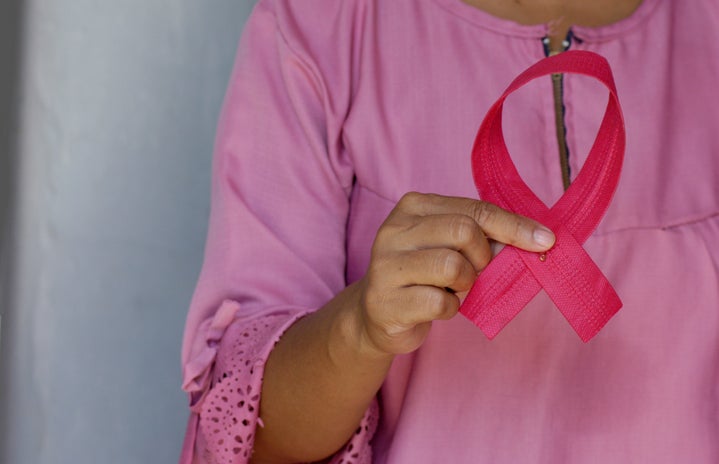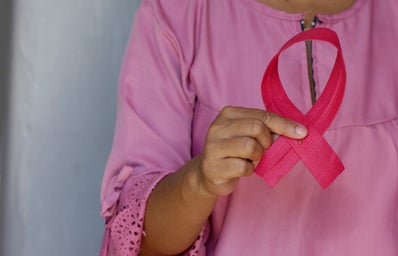October is known for the slight color change of the trees on campus and the sporadic cooler days. However, October is also known for a more important reason: Breast Cancer Awareness Month. Many people raise awareness about breast cancer by wearing pink to football games. However, now more than ever, it is crucial that we draw attention to those who are affected disproportionately the most.
Breast cancer is the most common cancer in women with the exclusion of skin cancers. Around one in eight women will be diagnosed with breast cancer in their lifetime. Of those, one in 39 will die from it. The risk of developing breast cancer can be affected by age and race/ethnicity. Non-Hispanic white and non-Hispanic Black women have around the same incidence of breast cancer. However, Black women have around a 40% higher death rate than their white counterparts. This disparity is called the “mortality gap” and has been a topic of breast cancer research.
Dr. Mam Mboge, who has been pursing breast cancer research for seven years, is investigating the triple negative subtype, which disproportionately affects and kills non-Hispanic Black women/women of African descent. Mboge is a current postdoctoral scholar at the Lawrence Berkeley National Laboratory and received her doctorate in biomedical sciences from the University of Florida (UF) College of Medicine.
The triple negative subtype of breast cancer is the most aggressive with very few effective treatment options. According to Mboge, about 21% of breast cancers in non-Hispanic Black women are triple negative, which is about double the proportion of this subtype in other racial/ethnic groups. This may help explain why Black women have a higher breast cancer death rate. However, there are numerous other factors to consider. For instance, Mboge points out “It is my opinion that genetic and environmental factors play a big role in determining when and what type of breast cancer any given individual gets, but health disparities definitely have more of an effect on the outcomes and how early a patient gets diagnosed with this disease.”
Risk Factors
According to the American Cancer Society, some risk factors of developing breast cancer include family history, age, genetic predisposition, breast density, height, menstrual cycles, hormone levels, breastfeeding, diet, alcohol, tobacco, physical inactivity, environmental pollutants and even taking birth control.
Health Inequities
On top of preexisting risk factors, Black women also face health disparities in terms of breast cancer prevention and treatment. Health disparities are defined as “a particular type of health difference that is closely linked with social, economic, and/or environmental disadvantage.”
These health disparities include inability to afford health insurance, lack of trust in the medical community, treatment in older and more run-down facilities, inability to find transportation to appointments, can’t afford to take off from work, etc. Black women are less likely than white women to receive a yearly mammogram and typically have a later stage of breast cancer at diagnosis. When it comes to treating breast cancer, financial barriers may delay or prevent treatment from occurring altogether.
How you can lower your risk
Mboge suggests getting screened regularly through mammograms, or similar methods, especially over the age of 40. Those with a family history of breast cancer who are under the age of 40 should also be screened regularly. The earlier the detection, the better the heath outcome. She also suggests avoiding carcinogenic substances in your environment and products. A health diet and regular exercise can also decrease your risk of developing breast cancer. All of these suggestions together can decrease your risk of developing or dying from breast cancer.
“Although the prognosis of breast cancer can be grim with adverse physical, physiological and financial effects on patients and their care givers, a lot of progress has been made towards understanding and treating this disease,” Mboge said. “Much more research and work need to be done so no woman, black or white, will ever die from this disease again.”.
What can you do to help?
One way to help close the mortality gap is to bring attention to it. While reports written on the health disparities Black women face in breast cancer prevention and treatment are helpful, they need outreach that will draw attention to them. In terms of making Breast Cancer Awareness Month campaigns more inclusive, Grace Kuenzli, a UF Nursing undergraduate, says “[It would] be beneficial for [Breast Cancer Awareness Month campaigns] to place more emphasis on highlighting information for BIPOC individuals.”
“It could help increase diversity and enhance inclusivity for these underserved and marginalized individuals in the advertisement’s message, which could overall help maintain their health,” Kuenzli said.
Including inclusive health, support and advertisements that draw attention to the mortality gap may help to increase screening rates and research into the issue. However, it is important that a sense of community is preserved amongst breast cancer patients and women who are at risk, as Alexandra Jean-Louis, a junior at the University of Central Florida, points out.
“I know that BIPOC women are affected disproportionally, and that fact should be made known,” Jean-Louis said. “I also think that it is important to not exclude the sense of community for breast cancer patients and survivors.”
“By ‘a sense of community’, I mean women feeling like they are divided, when they are all in this together,” Jean-Louis said.
Another way you can help is by sharing info on your social media, volunteering or donating to various organizations that aim to provide support for breast cancer patients and survivors. Below is a list of organizations that help breast cancer research, prevention, and treatment, along with some whose mission is to help Black women affected by breast cancer:
- American Cancer Society
- American Association for Cancer Research
- Breast Cancer Research Foundation
- Sisters Network Inc
- African American Breast Cancer Alliance
- Sisters by Choice
- Black Women’s Health Imperative
- Sisters on a Mission
This October do more than just wear pink. Donate, volunteer or even just click that “share” button to spread awareness about breast cancer and the mortality gap. Also, don’t forget to check yourself. Click here for a thorough guide on performing a self-breast exam from the Student Health Care Center. If you have a family history of breast cancer, or are at risk of developing it, make sure to regularly get mammograms or check yourself. If you suspect you may have breast cancer, please visit your primary care physician or local clinic as soon as possible.


